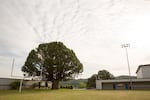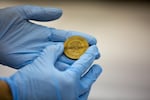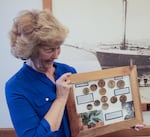Pat Choat Pierce remembers working at Duke's Drive-In, a restaurant in North Bend, Oregon, off Highway 101, in the late 1940s. A high school senior at the time, Pierce came of age in one of the most prosperous decades in U.S. history, which just so happened to follow the worst economic downturn the nation had ever faced.
“After the first week, Mr. Duke was not able to pay us. There was not enough money coming in at that particular time," she said.
Instead of her first week's pay, her boss handed over a pair of coins.
“So Duke said … ‘I'll give you this coin that is more than 2,000 years old — from Europe — and here's one of these $5 pieces that North Bend used to use — myrtlewood pieces. And you bring those back to me next week and then I'll give you your salary.’”
Pierce, whose mother was a coin collector, took the coins without any debate. She figured the Roman coin would make a valuable start to her own collection. She had no idea.

Lifelong North Bend, Oregon, resident Pat Choat Pierce poses with her collection of the city's myrtlewood money. Pierce is widely regarded as the foremost expert on North Bend's wooden currency.
Bryan M. Vance / OPB
The Roman coin turned out to be junk, not worth much due to its pervasiveness. But the myrtlewood coin — a $5 wooden piece given to her in 1948 — she still has it. It’s the anchor piece in her collection of North Bend’s one-of-a-kind currency, known locally as myrtlewood money. A local form of money that is still as good as cash in the boundaries of North Bend.
Hard times and creative measures
Myrtlewood money's story began in the early months of 1933. Life in America was hard in those days. The nation was in the midst of the Great Depression. Banks were foreclosing on farms and homes. Businesses were closing. Unemployment was estimated as high as 25 percent nationwide. And North Bend, a small timber and shipbuilding city on the Coos Bay, was not immune to the nation's woes.
In early January of that year, the town’s only bank announced a 30-day closure. It was intended as a measure to shore up the institution’s assets. But in the following weeks, no word came about when the bank would reopen.
Thirty-eight days after the First National Bank of North Bend closed its doors, the local newspaper ran a story about the Depression hitting the county jail. The jail was laying off its only cook.
“Prisoners in the county jail will do their own cooking or starve,” Coos County Commissioner Chas Doane told The Coos Bay Harbor. With news of the bank’s reopening still elusive, the directors and city leaders worked on a plan to save depositors’ money.
Finally, it was revealed that the bank was securing a loan on the value of its building to make good on its commitments to depositors. According to the paper, the First National Bank of North Bend would then either reopen on its own merits or be transferred into the control of one of two banks in nearby Marshfield, the modern-day city of Coos Bay. But still, no official date of reopening was available. By this point, citizens of North Bend had gone 51 days without access to their bank accounts.
"The city had to scramble," said retired North Bend High School teacher and Coos History Museum historian Steve Greif. "It had to pay its employees. It had firemen; it had police officers and city officials, a city manager; and they had to do something."

Coos History Museum historian and trustee Steve Greif holds one of the museum's $5 myrtlewood coins, printed for use within the city when the bank closed in 1933.
Arya Surowidjojo / OPB
On March 10, 1933 — 59 days after the First National Bank closed its doors— the city announced a plan: North Bend would issue its own currency. The city planned to print $1,000 worth of its own scrip to help stimulate the flow of commerce.
This wasn’t an original idea. All across the nation, towns and cities were dealing with a shortage of cash and a run on banks. Communities, municipalities, banks and community organizations began issuing their own currency to stimulate commerce. Most printed their money on paper or even wood. A few places got inventive.
In Morrow County, Oregon, the town of Heppner printed money on strips of sheepskin. In California, the town of Pismo Beach decided to use clamshells as cash. North Bend settled on wood. But not just any wood. A rare type of beautiful hardwood grown locally made this small coastal city's money a cut above the rest.
“North Bend did it in a beautiful, artistic unique way,” Greif said. “I know other places made wooden money, but I don't think anybody did it as beautiful as North Bend and did it quite as well.”

The North Bend myrtlewood coins varied in size based on denomination, with larger denominations being pressed into bigger coins.
Bryan M. Vance / OPB
A tree unlike any other
The Oregon myrtle (or California laurel, as it's also commonly known) is an enigma. It’s neither a laurel tree nor a myrtle tree, despite its common names. This broadleaf evergreen, known officially as the Umbellularia californica, grows only on a narrow strip of inland land along the Pacific Coast, ranging from northern California to Oregon’s southern coast.
“The myrtle tree is amazingly distinctive,” Greif said. “Once you see your first one and someone identifies it, you know you're there. And then if you go to touch it, you touch the bark or the leaves itself — the smell, you'll never forget it.”

A large Oregon myrtle tree grows in the end zone at Myrtle Point High School in Myrtle Point, Oregon.
Bryan M. Vance / OPB
The Oregon myrtle can take on various shapes depending on its surroundings. Left to grow alone, say in the middle of the end zone of a local high school football field, the tree can reach an impressive size, with a large, thick trunk and a beautiful bushy canopy. Full-grown myrtles can reach heights of 150 feet. But they also take on unusual shapes when growing in groves, usually sporting multiple trunks that twist and turn at various angles as they reach for the sun.
Locals are known to cook with the leaves, which are described as similar to bay leaves, only a bit spicier. But Oregon myrtle's real prize lies under its bark: The wood is what earned the tree its reputation as a coveted material.
Renowned for its beauty, myrtlewood has been a favorite of Oregon coast woodworkers for generations. It is the highest priced of all Western hardwoods, according to Oregon State University forestry professor Ed Jenson, who describes the tree in his book, “Trees to Know in Oregon.”
Many commonly known kinds of wood have a distinguishable look and features. Think pine or oak or cherry. Not myrtlewood. Its grain presents in various patterns. Its color ranges from the common blonde to the rare dark, with various hues of brown, gold and red along the spectrum.
“It draws the nutrients up from the soil, so whatever soil type that it grows in, it picks up the color variation from the nutrients,” Pamela Tonnemacher explained. Tonnemacher is the general manager of the Oregon Myrtlewood Factory, just across the McCullough Memorial Bridge from North Bend.

The sun pokes through the canopy of an Oregon myrtle grove at Hoffman Memorial State Wayside, south of Myrtle Point, Oregon.
Bryan M. Vance / OPB
Hers is one of the last remaining myrtlewood shops on this stretch of the Oregon coast. On any given day, customers from across the region and world stop in to peruse the selection of myrtlewood goods, ranging from kitchen utensils to intricately detailed pieces of furniture. While myrtlewood may not be as big of a business as it once was, shops like Tonnemacher’s help locals maintain a connection with this rare wood — a wood North Bend turned to in its time of desperation.
Making money
Back in the spring of 1933, North Bend got to work on getting the myrtlewood money into the hands of residents. The city chose a design and began work on issuing the first set of coins. Pressed on 1/4 inch-thick discs of myrtlewood in various diameters, the city’s new coins came in denominations of $10, $5, $2.50, $1 and 50 cents. Then-mayor Edgar McDaniel, who also served as editor of The Coos Bay Harbor, oversaw the printing of the coins on the paper’s presses and their distribution to the public.
It didn’t take long for the myrtlewood money to catch on.
“The newspaper advertised that it was good money, listed all the stores and people and the services in North Bend that would take the money, so it circulated a little bit,” Pierce recounted. City employees and contractors were paid with myrtlewood money, and they, in turn, spent it on goods and services throughout the community.

Each myrtlewood coin was pressed with the signatures of North Bend's mayor and treasurer, guaranteeing the city's backing of the currency.
Bryan M. Vance / OPB
Demand for the coins was high. Soon, the city decided to issue a second pressing of coins.
Changes were made to the coins for the second issue. The city had learned valuable lessons during the first round of printing and distribution. Most notably, the design on the second issue was more intricate, with details more spread out across the full face of the coin. They also scrapped the $2.50 piece, replacing it with a quarter.
“They did a much better design, a much more attractive coin for the second coin,” Pierce said. “One reason being that they found when they printed the first issue the way it was designed the printing was on more the center of the coin, and when they tried to print it on the big newspaper press it would snap so they lost a lot of coins that way.”
The attention to design proved especially important for myrtlewood money’s fate.
While the coins proved useful in keeping the economy moving, they also were gaining a reputation far and wide for their beauty. The rarity of the wood made counterfeiting the coins difficult, and collectors appreciated the attractiveness of the design.
The coins were so popular that at one point the Klamath Falls Chamber of Commerce discussed the possibility of working with the North Bend Myrtlewood Factory to make money for their city. Collectors across the region clamored for the money. The word was out. The coins’ popularity, however, ultimately led to the currency falling out of circulation.
“When December came there really weren't enough people who wanted their money that way,” Pierce said of the coins. “They were keeping it for souvenirs so the money has never been declared finished, even though it had a deadline time printed on it. It is still as good coinage today as it was back in 1933.”
Ultimately, the coins' beauty made it more valuable as a collectible than a currency.
"That's the beauty of myrtlewood is that no two coins are alike,” Greif said. “And that's probably another reason that collectors think of them as being highly unique.”
And the beauty of the coins is evident to this day.
On a rare opportunity to see a coin outside of a collector’s protective case, you’ll notice a glossy sheen on each coin. Back in 1933, after they were pressed, they were covered in a clear veneer. That veneer has helped the coins maintain their beauty nearly 90 years after they were printed.
“Certainly, because they are of substance, they're not like a piece of paper which can fold, burn, get mutilated, thrown away usually, they've survived well,” said local historian and former coin dealer Dick Wagner.
Nowadays, you're unlikely to find someone actually willing to use these coins as cash, despite the fact that they remain legal tender within the city limits of North Bend. A $1 piece from the first issue sold in 2016 for $75 — a 7,400 percent premium over its declared value.
“I would say at a minimum the most common are worth from $20 to $30 on the retail market,” said Wagner. “And the more expensive ones get you into the hundreds, and the rarest ones — the $10s — can't be priced because they're so rare that they just don't trade.”

North Bend resident Kristie Robertson Smith possesses one of the few known complete collections of myrtlewood currency. She has one of each denomination from both issues, including the rare $10 pieces.
Bryan M. Vance / OPB
Just how rare are we talking? There is only one known complete collection of both issues of coins still in Oregon. It belongs to Kristie Robertson Smith, who inherited her father’s collection when he died in 1969. Even Pierce, widely regarded as the foremost expert on the coins, doesn’t possess a $10 from either issue.
It’s been 85 years since these coins jostled in the pockets of North Bend’s residents. Eighty-five years since a small town used a natural resource — and a bit of ingenuity — to weather a far-reaching crisis. And while the coins are no longer in circulation, their existence challenges the saying “money doesn’t grow on trees.” In North Bend, for a time, money did just that.
